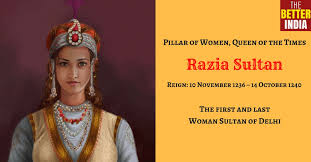Here’s a detailed expansion of Razia Sultan’s reign and her place in Indian history.
Razia Sultan, the daughter of Sultan Shams-ud-Din Iltutmish of the Mamluk dynasty, ascended the throne of the Delhi Sultanate in 1236. Her appointment as the Sultan was a remarkable deviation from the norms of the time, primarily because medieval Islamic societies typically did not accept female rulers. Iltutmish, recognizing her administrative capabilities and leadership qualities, nominated her as his successor over his sons, who he deemed unfit to rule.
Despite Iltutmish’s clear designation, Razia’s ascent was met with considerable opposition from the Turkish nobles, also known as the Chahalgani or the “Forty.” These nobles were influential and held significant power in the Sultanate. Their reluctance to accept Razia stemmed from both gender biases and their desire to maintain their own influence over the throne.
Razia Sultan’s reign, though brief (1236-1240), was marked by several notable administrative decisions and efforts to consolidate power:
- Razia attempted to strengthen the central authority of the Sultanate by reducing the power of the Turkish nobles, which naturally led to friction.
- She made efforts to improve the administration, encourage trade, and build infrastructure, including schools and public institutions.
- Razia broke gender norms by dressing in traditional male attire, leading armies, and appearing in public without the veil, which was unconventional and controversial at the time.
Razia’s rule faced continuous challenges, including revolts by discontented nobles. In 1240, she was deposed following a coup led by Malik Altunia, the governor of Bathinda, who initially revolted against her. Razia was captured and imprisoned but later married Altunia. Despite their efforts to reclaim the throne, they were defeated, and Razia was killed later that year.
- She remains the only female ruler in the history of the Delhi Sultanate, making her an iconic figure in Indian history.
- Her rule symbolizes defiance against the patriarchal norms of medieval society. Razia’s leadership and her struggle to maintain authority in a male-dominated world have been subjects of historical interest and inspiration.
While Razia was the first and only female ruler of the Delhi Sultanate, she was not the first woman to rule in Indian history. Several notable female rulers before and after her include:
- The queen of Gondwana in the 16th century, known for her valiant defense against Mughal forces.
- A revered queen of the Maratha Malwa kingdom, renowned for her administrative acumen and contributions to temple architecture and public welfare.
- A prominent leader in the Indian Rebellion of 1857, celebrated for her bravery and leadership.
Razia Sultan’s story is one of resilience, courage, and leadership against significant odds. Her reign, though brief, left an indelible mark on Indian history, showcasing the complexities and challenges of female leadership in a predominantly male-dominated society. Despite her downfall, Razia remains a celebrated figure, representing a break from the norms and an early example of female leadership in Indian history.national







